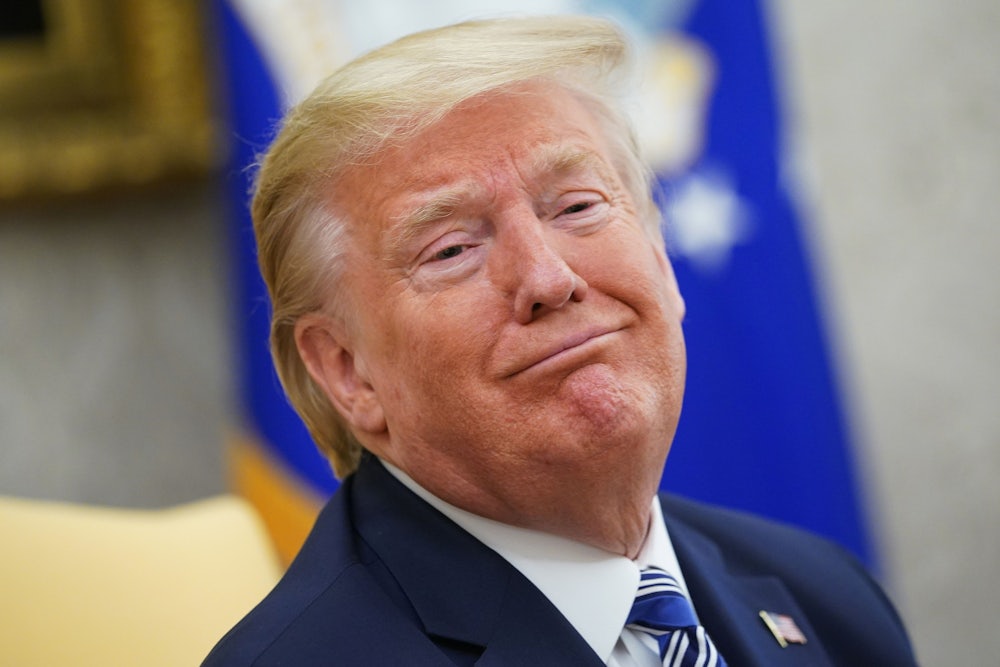Over the weekend, Donald Trump’s critics and his advisers were, possibly for the first time, on the same page: The president’s daily coronavirus briefings, which stretch on longer than Grateful Dead sets, were causing more harm than good. All it took for everyone to reach that conclusion was the president suggesting, in front of millions of viewers, that injecting bleach could cure Covid-19.
These briefings were both public health and political disasters, damaging the president’s already thin credibility and harming his reelection chances. The White House scrambled to come up with new briefings, now with reduced Trump. On Sunday, officials told Axios’s Jonathan Swan that the briefings would transition away from discussions of public health and instead highlight economic “success stories.” New White House Press Secretary Kayleigh McEnany teased that the briefings might not always feature the president, though they would always “showcase” his “great entrepreneurship.”
Trump appeared to have finally learned a lesson that had eluded him for more than seven decades: More is not always better.
But as usual, Trump wasn’t actually with the program. On Monday, he appeared in the Rose Garden, as opposed to the White House Press Room. Otherwise, it was the same old Trump, this time denying he had suggested administering bleach with an “injection inside.”
The episode illustrated what we all should know by now: Every attempt to constrain or change the president inevitably ends in failure and a return to the chaotic norm.
The clamor to shake up the briefings began with the media itself. “These White House sessions—ostensibly meant to give the public critical and truthful information about this frightening crisis—are in fact working against that end. Rather, they have become a daily stage for Trump to play his greatest hits to captive audience members,” wrote Washington Post media critic Margaret Sullivan in mid-March, pleading with cable networks to stop broadcasting the briefings. Editing Trump, the argument went, would allow fact-checking and reduce the chances of the president’s misinformation spreading.
There was also a fear that Trump’s briefings were good for him politically, that he would use them to sell the public on lies about his administration’s woeful coronavirus response. But though he originally saw a “rally around the flag” polling bump, he has since receded back to his disastrous precoronavirus approval numbers.
“I am worried about overexposure, yes,” a person close to Trump told Politico. “Bickering with the media for two hours on live television does nothing to help Americans who are struggling right now and want to know how and when their lives will return to normal.” By April, Trump’s advisers were telling him that if he wanted to win in November, he’d better take a back seat now. Health and economic advisers could sell the public on the administration’s actions without the distractions of Trump’s endless skirmishing and conspiracy-mongering. By the weekend, these advisers were declaring victory, briefing the media that the administration was changing its tune.
But the president was actually digging in. He spent Sunday tweeting a barrage of lies, claiming that he was being “sarcastic” when he suggested that scientists test the efficacy of injecting disinfectant and sunlight. He then sent a succession of tweets admonishing journalists for seeking a prize that doesn’t exist (the “Noble Prize” in journalism), then claimed the gaffe was a punning critique. On a day when the White House was trying to reset, the chyrons and headlines were, once again, about the president doing something idiotic.
It was abundantly clear that it just wasn’t possible to get Trump out of his own way. It’s a whack-a-mole problem. Even if Trump sidelines himself, he appears somewhere else, spouting the same paranoid, moronic near-gibberish that he would if he were “briefing” reporters. It took days for his advisers to convince Trump to change his approach, and the returns were marginal. Trump’s briefing on Monday was, by his standards, only slightly unhinged; there is every indication that he will be foaming at the mouth within a day or two.
The idea that Trump can be somehow hidden from the public is foolish. There is no hiding Trump. “He is the only one who thinks he can do his message the best, and that’s just the reality,” former adviser Sam Nunberg told Politico. “That’s how he works.” The White House can try to marginalize him, but he’ll always find a way to grab a megaphone.
